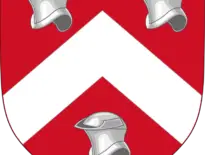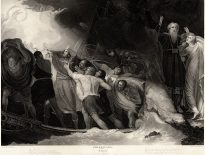Eustace Chapuys was born in Annecy; his exact birth date is unknown but is believed to be between 1490 and 1492. He was the second son of Louis Chapuys, notary of Annecy in the Duchy of Savoy.
Eustace Chapuys was a very well-educated man, attending the University of Turin in 1507, where it is believed he stayed for five years, leaving in around 1512. Chapuys became a doctor of civil and canon laws and had an interest in humanist scholarship. His degree paved the way for his appointment in 1517 when he was employed as an official to the Bishop of Geneva and represented the bishop in the government of the city. In the years following this appointment, Chapuys delicately handled strained political alliances, representing his bishop and the Duke of Savoy. In 1525, Chapuys entered the services of the Duke of Bourbon, acting as his ambassador to Charles V’s court in Granada. Following the death of the Duke of Bourbon, Eustace entered into the service of Charles V the Holy Roman Emperor, and by the 25th June 1529, he was appointed as Charles V’s ambassador to England. It is this appointment which guarantees Chapuys’ place in history as an important historical figure.
Upon his arrival in England, Chapuys became the close confidant of Katherine of Aragon, whom at the time, was facing humiliating divorce proceedings set in motion by Henry VIII, to secure marriage to Anne Boleyn. Due to his position and proximity to Charles V, Chapuys was a natural ally for Katherine of Aragon, the aunt of Charles V. Chapuys, therefore, acted as Katherine’s personal means of communication to the emperor throughout the divorce proceedings. Their relationship would lead to a closeness between the two and a complete show of devotion and loyalty to Katherine from Chapuys. Chapuys urged Charles V to harry Pope Clement VII into making a decision regarding the divorce, but Charles was wary of driving Henry into the arms of the French, and he was also preoccupied with the Turks. Chapuys, however, was not dissuaded from his cause, urging Charles V to impose a trade embargo, preventing trade to the Netherlands, leading Henry to have no choice but to retract the divorce proceedings. However, despite his best efforts, Chapuys was unable to bring this about and despite warning the emperor and the pope of the ascension of Cranmer to the now vacant position of archbishop, his appointment went ahead, followed by the secret marriage of Anne Boleyn to Henry VIII and her coronation in June. This was undoubtedly a blow to Chapuys who held Katherine in exceedingly high esteem and would not wish to see her humiliated.
Although the divorce proceedings were complete, Chapuys was still actively involved in the life of Katherine of Aragon and her daughter Mary. Katherine refused to accept her new position, and insisted that she be addressed as queen and Mary as princess. Chapuys was not allowed to see either woman, however, he remained in close contact and still provided a channel of communication to the emperor. In 1533, Chapuys and Thomas Cromwell began a series of private meetings, disguised as hawking parties. Cromwell impressed upon Chapuys that Katherine’s stubbornness was all that stood between herself and a better life for her and her daughter and if she complied all troubles would be at an end, including any threat of poison. It was intended that Chapuys convey these messages to Katherine and Mary. Although politically opposed to one another, Cromwell and Chapuys begrudgingly entered into a sort of wary friendship, both respecting the others intellect and stimulating conversation. It is through surviving letters from Chapuys and Cromwell and vice-versa that we are able to delve into their relationship, which details their wary respect for one another and their proximity, living near one another at Austin Friars in London.
In 1534, with the passing of the succession act declaring Princess Mary a bastard, Chapuys believed that Mary would do something reckless, and applied for permission to see Katherine at Kimbolton in Huntingdonshire. The king did not reply and thus Chapuys, with a large retinue including Spanish merchants, approached Kimbolton; however, they were stopped five miles short of the house. Eventually making a ruckus singing Spanish songs loudly around the moat, they were given entrance. This action is demonstrative of the depth of his loyalty for Katherine and Mary, refusing to be placated and denied the right to see them. It was this loyalty to Katherine which permeated his impressions of Anne Boleyn, whom he consistently referred to as ‘the concubine’ refusing to acknowledge her new title of queen.
In December 1535, Katherine’s health deteriorated, and Chapuys was granted permission to see her at Kimbolton. He was with her from the 2nd to the 6th of January, after which she died the next day. Chapuys was deeply saddened and convinced that Anne Boleyn had a hand in her death, using Italian poison. For many, however, the death of Katherine paved the way for improved relations between England and Spain. Chapuys was finally forced into the recognition of Anne as queen in April 1536, when he was manoeuvred into her presence and, as etiquette dictated, bowed. Chapuys, however, would not instigate a formal recognition of Anne, and reported that Henry was looking for a third wife, tired of the ‘concubine.’ Following the fall of Anne Boleyn, Chapuys was hopeful for the restoration of Mary. Mary, however, was resolute in her position and refused to acknowledge the invalidity of her mother’s marriage. Chapuys was instrumental here, managing to get Mary to sign a series of papers and to write a letter of submission to the king.
From the year 1536 onwards, Chapuys became less prominent in directly influencing internal affairs, but he still reported dutifully to the emperor regarding the political climate in England. Chapuys pressed the cause of a marriage between Mary and Dom Luis, the brother of the King of Portugal, to improve Anglo-Imperial relations; however, this came to nothing. Following the birth of Prince Edward, Chapuys’ role in Mary’s life appears to diminish, with Mary perhaps not wishing to risk her newly improved relationship with her father. Chapuys remained as ambassador, however, and in the 1540s was directly involved in the negotiations between England and Spain and the alliance between them, which, in 1543, would result in Charles and Henry declaring war on France. Despite suffering from gout, Chapuys accompanied Henry’s invasion force into France.
In 1544, claiming ill-health, Chapuys requested that he be relieved of his duties and the emperor dutifully acceded, on the condition that he introduce his successor to the post, and provide instruction and advice. Following his assignment to commercial negotiations with the English delegation at Bourboug, he was finally relieved from service in July 1545 although he still was consulted on English affairs, writing a state paper in 1547 regarding the political situation as Henry VIII was dying. Chapuys retired to Leuven where he used his accumulated wealth to set up a college for students from Savoy and, using his pension from England, declared that a scholarship for English students should also be set up. Chapuys died on the 21st January 1556 and was buried in the chapel of his college.
The life of Chapuys was undoubtedly shaped by his devotion and loyalty to Charles V but perhaps more importantly to Katherine of Aragon. His devotion to her cause and consistent support is heart-warming and details the genuine affection he must have felt for her. It is through his involvement in her life that we are able to witness the network of communication and influence of Chapuys in the court of Henry VIII and his fascinating relationship with figures such as Katherine, Henry and Thomas Cromwell.
By Georgia Whitehead
Georgia has just finished her masters in Classics at the University of Edinburgh. Academically, Georgia is interested in early Christianity, with her master's thesis focusing on "The Male Gaze and Self-Representation in Female Christian Narratives". In addition to her interest in ancient history, she has always been an avid lover of the Tudor era, drawn to the magnificence of the Tudor courts and the larger than life characters. She is particularly interested in The Reformation, Christianity and the shifting sands of ecclesiastical politics in this period and also has a keen interest in the lives of Tudor women. It is Georgia's ambition to become a writer, perhaps publishing her own Tudor novel one day.
Bibliography
- Borman, T (2014). ‘Thomas Cromwell: The Untold Story of Henry VIII’s Most Faithful Servant’, Hodder & Stoughton.
- Davies, C.S.L (2004), ‘Chapuys, Eustache’ Oxford Online Dictionary of National Biography.
https://www.oxforddnb.com/view/10.1093/ref:odnb/9780198614128.001.0001/odnb-9780198614128-e-70785 - Ives, E. (1986). ‘The Life and Death of Anne Boleyn’, Oxford: Basil Blackwell.
- Mattingly, G (1942). ‘Catherine of Aragon’, London.
- Mattingly, G. (1932). ‘A Humanist Ambassador.’ The Journal of Modern History, 4(2), 175-185. www.jstor.org/stable/1871667.



Wonderful essay, thank you! Eustace Chapuys was a very interesting Tudor figure. I’d been interested in him since The Tudors tv series. Michelle t
Am currently reading, with considerable enjoyment, Diarmaid MacCulloch’s ‘Thomas Cromwell: A Life’, to which the above paper on Chapuys makes for a clear explanation of the latter’s role in the affairs in England in the late 1530’s. Thank you.